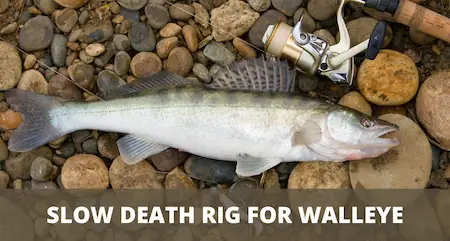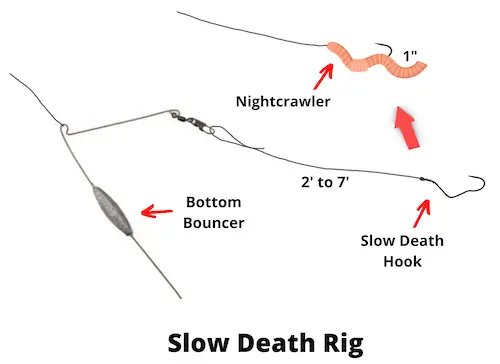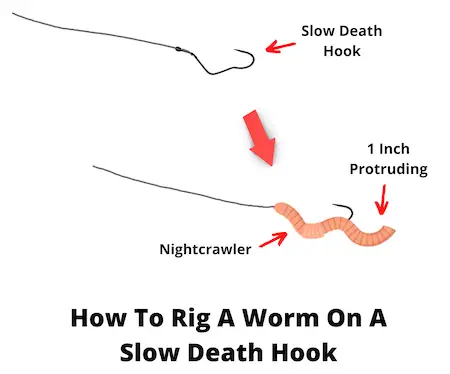Slow Death Rig For Walleye (Detailed Guide)
UPDATED 03 NOVEMBER 2023
by Robert Ceran
When the slow death rig was first introduced a few years back, it took the walleye fishing world by storm, and was touted as a secret weapon that enabled many walleye tournament wins for the anglers who knew about it.
While the slow death rig is not quite as effective as it used to be (since it’s used by so many walleye anglers nowadays), it is still one of the best walleye trolling rigs out there, and should definitely be part of your arsenal for successful walleye trolling.

In this article we’ll explain what a slow death rig is, how to set it up correctly, and how to fish it for walleye to achieve optimal results.
What is a slow death rig?
A slow death rig is a trolling rig consisting of a weight, a leader, and a slow death hook.

The hook has a long shank which is bent in a triangular shape to make it spin with a slow rotating movement when pulled through the water, and is baited with either a nightcrawler or a leech.
The slow death rig is most often combined with a bottom bouncer weight and used for trolling walleye, but it can also be combined with other weights (such as a Lindy rig), and it also works well for trolling trout.
Now let’s take a look at the details, and talk about how to tie a slow death rig, and how to use it most effectively.
Slow death rig setup
Since a slow death rig is most often used together with a bottom bouncer, we’ll explain how to set that up. Here are the components you’ll need in order to rig a slow death rig with a bottom bouncer:
- Main line: 10 to 15 lb test braid (or monofilament)
- Leader: 6 to 12 lb test fluorocarbon (or monofilament)
- Hook: Size 1 to 4 slow death hook
- Weight: 1 to 3 oz bottom bouncer
Start by tying your main line to the bottom bouncer. I recommend using braid as your main line, as that provides more sensitivity in terms of being able to feel when you hit bottom with the bottom bouncer weight (since braid has almost no stretch).
Another advantage of a braided main line is that it has a smaller diameter than mono for the same line strength, which enables your rig to get down in the water column more easily, since there is less drag pushing your line up in the water.
Next, take your slow death hook (I recommend size 2 Mustad slow death hooks), and snell it onto your leader line.
Fluorocarbon is usually the best choice as leader, as it has the lowest visibility in the water, and doesn’t spook shy walleye as easily as other types of fishing line.
After snelling the hook, measure out between 2 to 7 feet of leader line, and tie a loop at the end of your leader.
The length of the leader depends on how shy the walleye are – the more finicky the walleye, the longer it should be.
Finally, clip the loop of your leader to the snap swivel of the bottom bouncer, and you’re good to go.
This is the basic version of the slow death rig, which is great for catching walleye in most situations, but you can also combine it with a spinner rig in front of the hook, a spin-n-glo bobber, or a sliding float threaded onto the leader above the hook.
These variants create additional vibrations and light signals in the water, which can help to trigger walleye bites when the fish don’t respond to the basic slow death setup.
How do you rig a worm on a slow death hook?
Poke the tip of your slow death hook into the end of the nightcrawler, and thread the worm slowly onto the hook until the hook is completely inside the worm.

Next, poke the tip of the hook out of the side of the worm, so that it sticks out.
Finally, cut off the worm about 1 inch behind the hook (don’t use a whole worm, since that will result in a lot of short strikes).
Slow death hooks are designed to be used with big nightcrawlers, but it’s important to rig the worm correctly in order to trigger bites.
Make sure to thread the nightcrawler past the tag end of the snell knot of the slow death hook, as that will help to stop it sliding down the hook while you’re trolling it.
Most slow death hooks have at least one additional barb on their shank to prevent the worm sliding down, but in my experience the tag end of the snell knot is more effective for this purpose.
How to fish a slow death rig for walleye
Now let’s talk about slow death fishing for walleye, and how to get the best results with this rig.
By far the best way to fish this rig is to troll it, which allows you to cover a lot of ground in search of hungry walleye, and is one of the most effective methods for catching walleye in the peak of summer.
Trolling a slow death rig
When trolling a slow death rig, it’s important to troll at a slow speed between 0.7 and 1 mph.
While you can go up to a speed of 1.2 mph, slower is usually better with this rig, since that gives the walleye more time to catch up with your bait, take a closer look at it, and then eat it.
While trolling a slow death rig, it’s important to maintain constant contact with the bottom with your weight, and the best way to do this is to keep an eye on your fish finder, and let out more line if you notice the water getting deeper, or reeling it in if you see that it’s getting shallower.
In order to do this effectively, it’s usually best to use a slightly heavier weight around 2 or 2 and a 1/2 oz, as that will enable you to get your rig down to the bottom faster when you notice the depth changing.
If the walleye aren’t biting aggressively, and instead just nipping at your bait, you may want to switch from a bottom bouncer to a sliding weight setup (such as the Lindy rig setup), which allows you to give the walleye some slack line before setting the hook.
In many cases, that will result in a higher hook up ratio, as it gives the walleye a chance to eat your bait before you set the hook.
Also, if you notice that the walleye are suspended slightly above the bottom, you can thread a small sliding float onto the leader, just above your slow death hook, as that will lift your presentation up in the water.
You can then adjust the exact depth by how long you make your leader, and also by how fast you troll this setup.
